





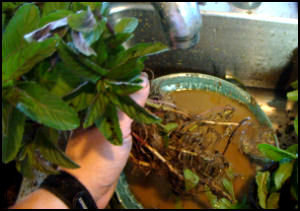 PREPARE THE PLANT
PREPARE THE PLANT
For many plants, sending them bare root works best. You don't want to pay for shipping dirt or pots, you want to pay for shipping actual plants. Also, you don't want rigid pots or clods of dirt in the box that can rattle around and bruise or damage the plants. When you dig and divide the plant or take it out of the pot, a good shake may remove most of the soil from its roots. Anything that remains may be rinsed off at the hose or by holding the plant by its top and giving the roots a gentle swish in a bucket of water.
WRAP THE ROOTS
The roots do have to stay moist and protected during shipping in order to keep the plant healthy. Moist paper towel works well to wrap the roots. Run the paper towel under the tap, then wring it out so it's nicely damp but not dripping wet.
I give the roots a reservoir of extra water by adding a couple spoonfuls of hydrated regular or powdered polymer moisture crystals. Half a teaspoon of powdered polymer can be stirred into about a cup of water to make a slurry for dipping roots or smearing onto the surface of a damp paper towel. I keep a covered jar of polymer slurry on hand for quick wrapping jobs.
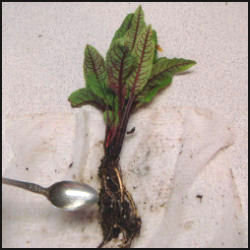
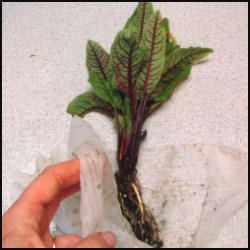
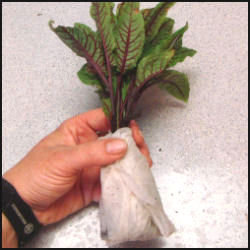 Add hydrated polymer moisture crystals and bundle roots in moist paper towel.
Add hydrated polymer moisture crystals and bundle roots in moist paper towel. 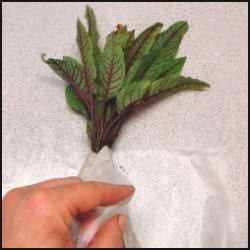
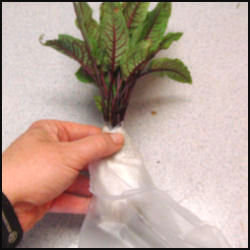
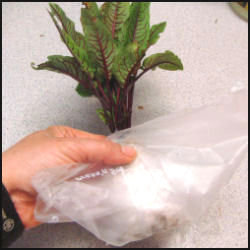 Bring Glad Press 'n SealTM around and up from bottom of rootball to form a watertight packet.
Bring Glad Press 'n SealTM around and up from bottom of rootball to form a watertight packet. 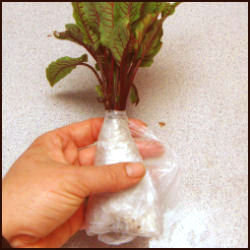
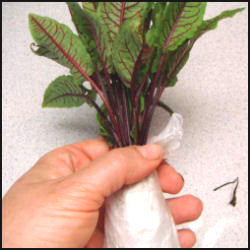
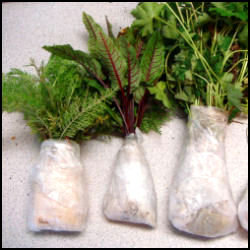 Plastic wrap should completely cover paper towel and be snug around base of stems.
Plastic wrap should completely cover paper towel and be snug around base of stems. Gather all the stems and foliage into one hand, then lay the roots onto the damp paper towel with its coating of polymer slurry. Wrap the roots into a bundle with the paper towel, trying to keep the foliage relatively dry.
Now you need a way to keep the water from evaporating from around the roots during shipping. Plastic is the answer, and there are many ways to wrap the root ball in sandwich bags, saran wrap, etc. One of the best materials I've found for wrapping the roots is Glad Press ‘n SealTM, which seals to itself to form a tight, waterproof packet.
Whatever material you choose, make sure the plastic completely covers the paper towel around the roots and does NOT come into contact with the stems and foliage. Plastic around leaves leads to condensation and rot. In hot weather, plants completely covered in plastic may arrive at their destinations steamed and looking as limp as cooked spinach.
WRAP THE TOPS
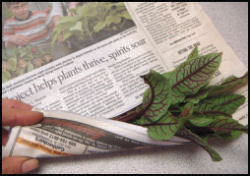
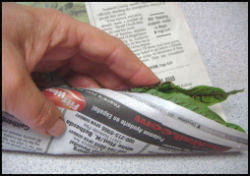
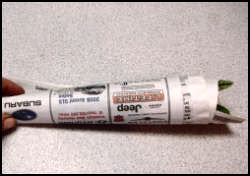
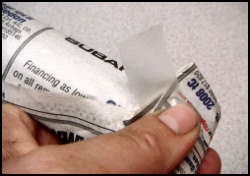
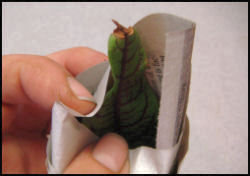
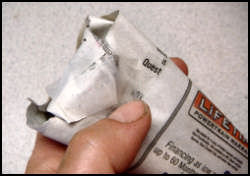
With the roots wrapped to stay moist and protected during shipping, turn your attention to the top of the plant. Stems and foliage should not touch plastic, as explained above, but some wrapping is good to cushion and insulate them. The method I use involves wrapping the entire plant in a tight cone of newspaper, similar to the way a florist might wrap a bouquet of flowers. Lay the plant down at the edge of the paper, gathering the foliage together into a bundle with the leaves pointing upwards. As you roll the paper around the plant, tuck and smooth any wayward stems so the foliage fits into a fairly compact cylinder or cone of paper. Use a couple pieces of tape to secure the bottom and top of the paper.
LABEL & PACK
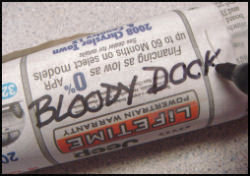
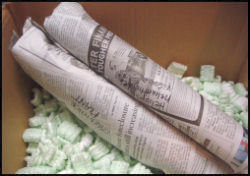
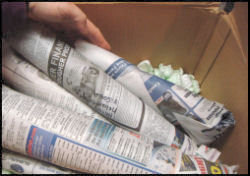
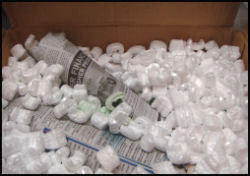
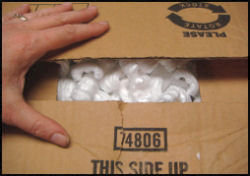
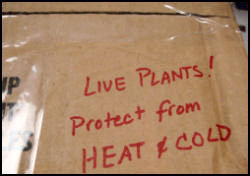
Don't forget to label the plant! Whether you include a nice garden marker taped to each packet or simply write the name of the plant on the paper enclosing it, be sure to clearly label each plant.
Choose a box that will hold all the plants you're sending with extra room all around for insulating material. Shredded paper, styrofoam packing peanuts, crumpled newspaper, bubble wrap, and even crumpled plastic grocery bags work well to cushion and insulate plants during shipping. Insulation is important to protect the plants from any extreme hot or cold temperatures along the way. Slightly overstuffing the box will ensure that nothing can rattle around once the box is sealed.
If you're sending a single plant, or including a heavy item with the plants in your box, you might want to secure it to the box with tape. If you tape anything to the inside of the box, please consider what will happen at the other end. Make the tape easy to remove or cut so the item can be removed without damage or the possibility of unladylike language.
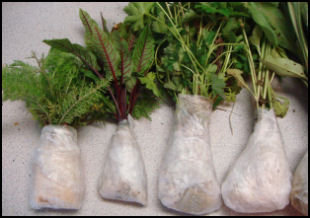 Whether you use the postal service or a private carrier to ship your box, be certain your shipping label is clearly printed. Although your plants should be well protected by your packaging, it's not a bad idea to add a cautionary "Live Plants!" label in the hopes that the box will be handled gently. Before you ship, check restrictions and regulations at the other end. Some states have strict rules now, and international trading is another thing entirely. You don't want your carefully packed plants to be confiscated and destroyed!
Whether you use the postal service or a private carrier to ship your box, be certain your shipping label is clearly printed. Although your plants should be well protected by your packaging, it's not a bad idea to add a cautionary "Live Plants!" label in the hopes that the box will be handled gently. Before you ship, check restrictions and regulations at the other end. Some states have strict rules now, and international trading is another thing entirely. You don't want your carefully packed plants to be confiscated and destroyed!
SUMMARY
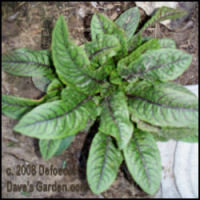 For bare root plants, wrap the roots with damp paper towel, hydrated moisture polymer, and plastic. Wrap the tops in paper. Surround with some sort of packing material to cushion and insulate the plants. Send them on their way and cross your fingers. With a little luck, your plants will soon be flourishing in another garden!
For bare root plants, wrap the roots with damp paper towel, hydrated moisture polymer, and plastic. Wrap the tops in paper. Surround with some sort of packing material to cushion and insulate the plants. Send them on their way and cross your fingers. With a little luck, your plants will soon be flourishing in another garden!
Photos by Jill M. Nicolaus. Thanks to Defoecat for sharing the final photo of our subject plant in its new home in her garden!
Copyright © www.100flowers.win Botanic Garden All Rights Reserved